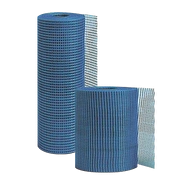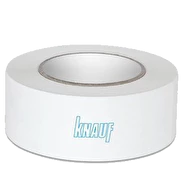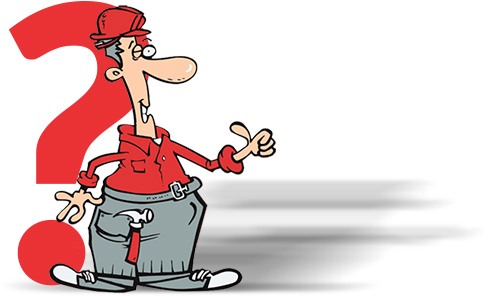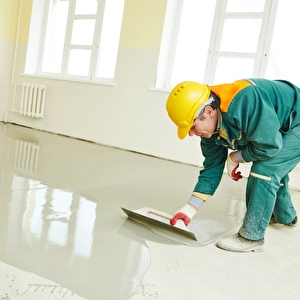Product description
Field of application
- Floating sleeper, thickness ≥ 35 mm;
- Heating pad, thickness ≥ 35 mm above the heating element;
- Underlay on a distribution layer, thickness ≥ 30 mm;
- Composite sleeper, thickness ≥ 25 mm;
- Supporting underlay in Knauf Camillo.pl raised floor, thickness ≥ 35 mm;
properties
- Self-leveling properties
- High heat transfer coefficient
- Machining
- A level surface without sanding
- Stable form
- Early loading option
- For use indoors
Knauf FE 50 Largo liquid accompaniment anhydrite Knauf FE 50 Largo dry mortar based on calcium sulphate containing fillers and flow agents (0-4 mm). Classified by PN EN 13813: CA-C25-F5.
Method of implementation
Knauf FE 50 Largo liquid undercoat should be mixed with clean water and pumped onto the previously prepared surface using mixing pumps. The recommended flow diameter is about 38-43 cm - it is determined using a 1.3l can for measuring consistency. Water should not separate from the mortar during pouring. For small areas, Knauf FE 50 Largo can be mixed by hand. To do this, mix 1 bag (30 kg) with 4 liters of clean water and mix until a homogeneous and lump-free consistency is obtained.
Expansion joints
Knauf FE 50 Largo undercoat binds without shrinkage, so there is no need to create expansion joints. Exceptions are heating underlays and building expansion joints, which should be kept in the same places at the height of the entire screed. Working technological expansion joints can be used depending on the needs arising from the progress of work, the size of the facility and the efficiency of the machines.
Expansion joints in the heating foundation
In the case of a heating underlay, it is recommended to plan expansion joints in door openings, on 10-meter-long surfaces, at constrictions, faults and when separating heated from unheated surfaces.
Heating of heating bed
Knauf FE 50 Largo underlayment used as a heating underlayment should be dried thoroughly before laying the floor. The recommendations for screed heating are as follows:
- They should be started 7 days after applying the foundation,
- It should take place at a temperature of 25 ° C and last 3 days;
- After 3 days, raise the temperature to a maximum, but not higher than 55 ° C. Optionally, you can also raise the temperature gradually, by 5 ° C each day.
- The maximum temperature should be maintained until the primer dries completely.
Approximate drying time at the maximum flow temperature is:
- 10 days at 55 ° C (thickness: 50 mm)
- 12 days at 45 ° C (thickness: 50 mm)
Initial residual moisture control should be performed using a foil test. After drying, the supply temperature should be reduced so that the surface of the undercoat reaches about 15-18 ° C.
drying
Before applying the floor, check the residual humidity using a CM moisture meter. Its permissible value is:
- Up to 0.5% for vapor-tight floors, e.g. PVC
- Up to 1.0 * for vapor-permeable floors, e.g. ceramic tiles
- Up to 0.5% for all floors with underfloor heating (refer to the detailed heating instructions).
The drying time of a 35 mm thick anhydrite liquid primer is usually between 3 and 6 weeks and depends on the general drying conditions - temperature, humidity and air circulation in the room.
Weathering started from day 2 after pouring the undercoat accelerates the drying process.
Technical data
Specific weight - wet approx. 2.25 kg / dm3
Specific gravity - dry approx. 2.05 kg / dm3
Processing time - approx. 60 min
Modulus of elasticity - 17 kN / mm3
Possibility of walking - after approx. 24 hours
Charging option - after approx. 72 hours
Reaction to fire - A1
Expansion during binding - about 0.1 mm / m
Heat transfer coefficient - 1.4-1.6 W / mK
Coefficient of thermal expansion - 0.016 mm / sq m
Release of corrosive substances - CA
Compressive strength -> 25 N / mm2
Bending strength -> 5 N / mm2
Storage
Bags that are not damaged and are stored in a dry place on wooden pallets can be stored for up to 6 months from the date of manufacture.
In the case of damaged bags, the contents should be poured and used first. Protect the rest against moisture.
Efficiency
Consumption per 10 mm - 19 kg / m2
Safety and disposal instructions
The presented technical card defines the scope of use of the material and the recommended way of performing the work. However, it cannot replace the proper preparation of the contractor. All work should be carried out in accordance with the principles of health and safety and general building practice. The manufacturer declares that it guarantees the quality of the product, but is not responsible for the effects of its incorrect use.
anhydrite spout - a warm climate in your home
For underfloor heating to function well, it must be installed on a properly prepared floor. It should not isolate heat generated by heating pipes, but conduct it well and efficiently release it into the room.
Short heating time
A perfect complement to the underfloor heating system is the use of Knauf FE 50 Largo self-leveling anhydrite screed. It shows a particularly high heat transfer coefficient (λz = 1.66 - 1.87 W / mk), which has a significant and direct impact on the efficient heat flow given off by the floor heating system. An additional advantage of the screed is its liquid consistency that does not contain air bubbles, which significantly improves the above process. Therefore, the period of heating the room can be reduced by up to half compared to the use of cement screed, which translates directly into the amount of energy saved.
Excellent also in the attic
Making anhydrite screeds requires a minimalist coating of heating pipes to achieve the least possible heat conduction resistance and reduce the weight of the screed. As a result, Knauf FE 50 Largo can also be used for wooden ceilings.
Save time and glue
The consistency of the Knauf FE 50 Largo anhydrite screed ensures its natural self-leveling properties, making it possible to obtain perfectly smooth surfaces. This allows you to reduce the cost of further finishing work by reducing the amount of adhesive needed to lay the terracotta. This type of screed also guarantees faster work.
No cracks
The characteristic feature of anhydrite screed is the lack of shrinkage during setting and drying, which often occurs with cement screeds. Therefore, there is no need for expansion joints, even for areas larger than 25m2. This allows much more freedom in terms of finishing the floor and does not disturb its appearance with visible expansion profiles. The properties of Knauf FE 50 Largo anhydrite screed reduces the risk of scratches and cracks, because during the anhydrite setting, no deformation characteristic of cement screeds, often referred to as the "bowl effect", is created. An additional advantage of anhydrite screeds is that they do not require reinforcement.
Simplicity and universality
The undoubted advantage of Knauf FE 50 Largo anhydrite screed is its ease and speed of implementation. Simple technology makes it easy to apply it yourself. It is also worth mentioning that on floors made of anhydrite screed you can lay almost any type of floor - both terracotta and parquet.
Enjoy your shopping. Placing an order by adding a product to the basket is not the same as buying a product, it is treated as a pre-order. The price of transport is determined by phone, the order becomes valid and is completed only after the customer accepts the price of transport.















Have you purchased this product?